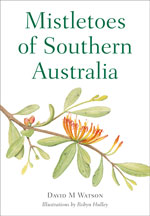 |
Mistletoes of Southern Australiaby David M Watson
Published in 2011 by CSIRO Publishing, colour paintings and photographs, 200 pages
Price $A49.95 plus $A12 postage within Australia [up to 3 kg], overseas postage please request a quote ISBN 9780643095939 |
- Contents
- About the book
- About the author
Contents
Preface
Acknowledgements
Biology
Identification
Species accounts:
Loranthaceae
Visaceae
Ecology
Cultural significance
Management
Species list
References
Index
About the book
Mistletoes are an enigmatic group of plants. Lacking roots and depending on other plants for their livelihood, they have inspired a range of beliefs throughout the world. Some people regard them as mystical plants endowed with magical properties, others as destructive weeds that devalue native habitats, and still others as beautiful native plants that support wildlife.
This book represents the first thorough treatment of mistletoes in Australia. It summarises their evolutionary origin and global distribution, highlighting diversity patterns in Australasia, and describes the ecology and life history of mistletoes, detailing the variety of animals that depend on them for food and shelter.
The book discusses the cultural significance of mistletoes, compares imported European beliefs with home-grown Indigenous lore and looks at the role of mistletoe in contemporary art, design and medicine. It also explores the management of mistletoes, noting those situations where mistletoe becomes too abundant and offering practical solutions to achieve a more balanced outcome. Finally, there is a guide to identifying mistletoes, including detailed species accounts for all 46 species found in southern Australia.
With 51 specially commissioned watercolours by artist Robyn Hulley and more than 130 colour photographs, Mistletoes of Southern Australia is the definitive authority on these intriguing native plants.
About the author
David M Watson is an ecologist with a long-standing interest in mistletoes. In addition to the ecology of parasitic plants, his research focuses on developing solutions to habitat fragmentation and managing biodiversity in agricultural landscapes. He lives on a rural property near Albury with his wife, three sons and a variety of other animals.